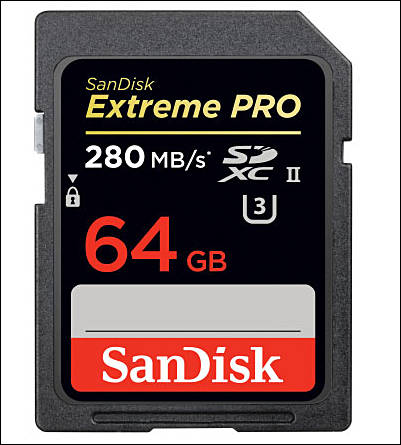
-

Today, SanDisk is announcing its latest flagship, the Extreme Pro SDHC/SDXC UHS-II. It exceeds the new UHS Speed Class (U3) spec, supporting continuous write speeds of up to 250MB/s. While the card is most appropriate for folks shooting 4K video, it'll also come in handy when you're snapping continuous RAW stills at high frame rates, letting you unload the camera's buffer just as quickly as you can fill it. The new cards will ship in April in 16GB to 64GB capacities, with prices ranging from $120 to $300. There's also a new U3 card reader that's designed to let you take full advantage of the SDXC card's 280MB/s transfer speeds. That device will also be available in April, with a $50 MSRP.

 fotga_stab10.jpg401 x 445 - 34K
fotga_stab10.jpg401 x 445 - 34K -
Kingston Digital, Inc., the Flash memory affiliate of Kingston Technology Company, Inc., the independent world leader in memory products, today announced its fastest addition to the Secure Digital product line. The new DHC/SDXC UHS-I Speed Class 3 (U3) card (Kingston part #: SDA3/xxGB) allows professionals and consumers to capture 4K and other Ultra-HD video resolutions. The new card is available in 16 GB, 32 GB, and 64 GB capacities.
The SD Association's latest specification, UHS-I U3 (Ultra High-Speed Bus, Speed Class 3), guarantees performance of at least 30 MB/s read and write, enough bandwidth to record and playback 4K video without interruption. Kingston's SDHC/SDXC UHS-I Speed Class 3 card provides speeds of 90 MB/s read and 80 MB/s write, which is up to 9x faster (read) and up to 8x faster (write) than standard Class 10 SD cards. The faster speeds ensure the best video and photo integrity by reducing stutter as well as faster PC upload time especially when using USB 3.0 card readers
-
Indeed, I would expect that for scenes with only small amount of random detail the higher resolution would not necessarily demand equally higher bitrate.
But with the usual torture test subjects like noisy high ISO images, fast moving water, crowds etc., shouldn't bitrate demand rise quite proportionally?
I guess we'll know for sure when new era of UHD test videos comes to the web:)
-
It is also good to understand that comparison can't be made in such way. As whole idea of lossy codecs is making losses were it is hard to see them :-)
So, it is not necessary to proportionally increase bitrate at such resolution increase. Same is true for fps increase (due to vision nature and also due to much better motion predictor work).
-
Simple math exercise just for the fun of it… Assuming the standard format of consumer UHD cams will be 3840x2160 8bit 4:2:0 30fps, it'll have uncompressed bitrate of about 373 MBytes/s (2 986 Mbits/s). Compressed bitrate of 30 MBytes/s (240Mbits/s) would mean a compression ratio of about 12:1.
For comparison, 1920x1080 8bit 4:2:0 30fps has about 94 MBytes/s (747 Mbits/s) uncompressed bitrate. Compression ratio of 12:1 would be achieved with 62 Mbps bitrate.
Assuming that codecs in upcoming UHD cams are at least as good as h.264 on current consumer HD cams, and they indeed use 30MBytes/sec bitrate, the image quality could be quite usable.
-
The German magazine "ct'" recently had an article on the status quo of both "UHS Class 3" cards and "UHS-II bus speed" support.
The bottom line at the moment is that there is only one very expensive card reader (Panasonic AJ-MPD1G) on the market that supports UHS-II and only one SD card that claims to support the "UHS Class 3" sustained write speed of 30 MB/s (Toshiba Exceria Pro 32GB).
It's amazing how much confusion the SD association is still creating with making people confuse bus speeds, peak transfer rates and sustained write speeds. And even the announced vapor-ware SD cards are slower than CFast cards that have been sold in quantities for quite some time now...
(The ct' article is available online only behind a pay-wall)
Howdy, Stranger!
It looks like you're new here. If you want to get involved, click one of these buttons!
Categories
- Topics List23,992
- Blog5,725
- General and News1,354
- Hacks and Patches1,153
- ↳ Top Settings33
- ↳ Beginners256
- ↳ Archives402
- ↳ Hacks News and Development56
- Cameras2,367
- ↳ Panasonic995
- ↳ Canon118
- ↳ Sony156
- ↳ Nikon96
- ↳ Pentax and Samsung70
- ↳ Olympus and Fujifilm101
- ↳ Compacts and Camcorders300
- ↳ Smartphones for video97
- ↳ Pro Video Cameras191
- ↳ BlackMagic and other raw cameras116
- Skill1,960
- ↳ Business and distribution66
- ↳ Preparation, scripts and legal38
- ↳ Art149
- ↳ Import, Convert, Exporting291
- ↳ Editors191
- ↳ Effects and stunts115
- ↳ Color grading197
- ↳ Sound and Music280
- ↳ Lighting96
- ↳ Software and storage tips266
- Gear5,420
- ↳ Filters, Adapters, Matte boxes344
- ↳ Lenses1,582
- ↳ Follow focus and gears93
- ↳ Sound499
- ↳ Lighting gear314
- ↳ Camera movement230
- ↳ Gimbals and copters302
- ↳ Rigs and related stuff273
- ↳ Power solutions83
- ↳ Monitors and viewfinders340
- ↳ Tripods and fluid heads139
- ↳ Storage286
- ↳ Computers and studio gear560
- ↳ VR and 3D248
- Showcase1,859
- Marketplace2,834
- Offtopic1,320





